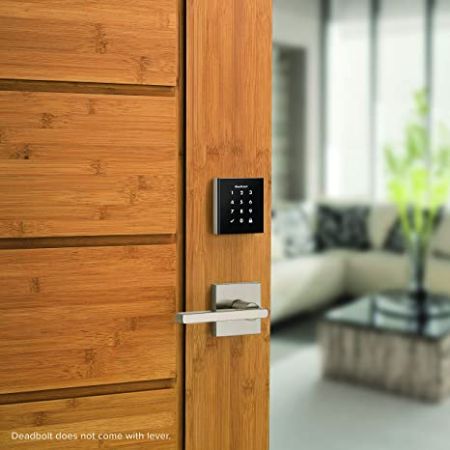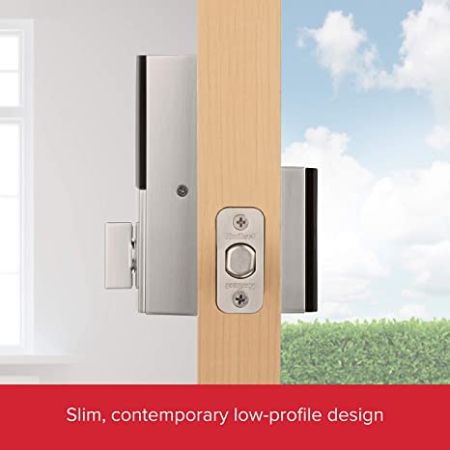Turns out Yale isn’t the main organization dealing with a smoothed-out touchscreen lock that, once introduced, won’t make your front entryway seem to be the entry to a bank vault. With the appealing Obsidian deadbolt, Kwikset enters a conflict that is quickly loading up with contenders.
While it’s an independent lock with no remote elements or application network (a Z-wave Plus form is underway), it’s an extraordinary-looking item, its outside crest simply a millimeter or two thicker than the generally comparative Yale Assure SL. It’s somewhat more limited, yet marginally more extensive than that lock.
The Obsidian comes in two completions — silk nickel and Venetian bronze — however, these are essentially highlighted on an item that is generally for the most part ebony. At last, while the Assure SL highlights adjusted corners, the Obsidian resembles a smooth dark square, complete with sharp edges. Both look great remotely; your own plan tasteful will be a major consideration picking between the two. (Sadly, the inside of the two locks remains completely modern.)
Cost and accessibility
The Kwikset Obsidian brilliant lock was sent off in 2017; it’s accessible in two variants: A non-associated model, which can stockpile 16 codes, costs about $140. An associated model, which works with Z-Wave shrewd home centers, costs about $210.
Performance
The Obsidian presently works with Z-Wave center points like Wink and SmartThings. While the Obsidian doesn’t presently work with HomeKit or Google Home and Kwikset has no devoted IFTTT administration, you can in any case lock the Obsidian with a custom IFTTT recipe utilizing Google Assistant and SmartThings IFTTT administrations. When I made a custom IFTTT recipe, I had the option to request that the Google Assistant lock the entryway with progress like clockwork.
The independent Obsidian acknowledges up to 16 client codes, while the Z-Wave adaptation upholds 30 codes. Each code should be somewhere in the range of four and eight digits. You can likewise empower a master code to support extra codes or eliminate them. To add a client code, press the programming button under the lock’s inside cover, press the mark image on the keypad, and enter a four-to eight-digit code followed by the lock image.
- SecureScreen prevents code guessing by other parties
- Clear, eye-catching design
- Clear installation process
- Occasionally requires several taps to respond
- Requires a Z-Wave hub for Alexa or Google Assistant to function
- Only has 30 codes
The Obsidian doesn’t have its own application like the Kevo lock, so you should make codes either through the actual keypad or your particular savvy home stage. SmartThings and the Alexa application didn’t offer this choice for the Obsidian when I tried. That is a mistake, as it would be truly good to have the option to remotely create codes.
Kwikset’s programmed relock includes locking the entryway 30 seconds after it’s opened. This worked each time for me. The SecureScreen capability additionally functioned admirably. While entering your code, Obsidian will incite you with two distraction digits.
Press those, trailed by your code. SecureScreen protects against would-be gatecrashers examining fingerprints, and I love it, particularly given the glossy touchpad is inclined to finger impression trails.
A LED on the inside side of the lock informs you as to whether the deadbolt is locked or opened. Like clockwork, the LED will streak golden for locked and green for open.
Setup and installation
The establishment of the Obsidian is simple, because of insightful contacts like the variety of coded screws for various entryway thicknesses. You can program up to 30 codes, which is far less than most other brilliant locks offer; likewise, none of the codes can be customized to lapse at a given time, which you can do with August’s shrewd locks.

If the four AA batteries that power the lock run out, you can contact a 9-volt battery to the foundation of the front touch-screen board and power the lock for a brief time.
Savvyhome similitude
If you have any desire to control or screen the Obsidian from a distance, you’ll need to interface it to a savvy home center point with Z-Wave; for a great many people, this implies getting Samsung’s SmartThings center ($70). Once associated, you’ll have the option to control the lock from your cell phone or with Alexa or Google Assistant.
Auto-Lock
You can switch this component off, as you can with SecureScreen, sound, and programmed relock. Getting to these switches is a piece irritating. A little leading group of minuscule switches under the inside side cover control every one of these elements. You’ll have to unscrew three screws on the faceplate to get to it. If you have any desire to handicap programmed relocking to invite a party or unique situation, you’ll have to track down a screwdriver.
Neither model of the Kwikset Obsidian offers a Bluetooth association, so there aren’t any keyfobs or approaching your entryway to open it with a telephone, similar to what we found in the Kevo. I wouldn’t fret about the shortfall of Bluetooth as an opening technique, however, it could deflect some of you.
Neither model of the Kwikset Obsidian offers a Bluetooth association, so there aren’t any keyfobs or approaching your entryway to open it with a telephone, similar to what we found in the Kevo. I wouldn’t fret about the shortfall of Bluetooth as an opening technique, however, it could deflect some of you.

In general, the Obsidian is exactly what you would anticipate from a touchscreen deadbolt, and the additional Z-Wave smarts and IFTTT prospects of the Home Connect variant make it a welcome option for savvy home schedules with Alexa. The Obsidian incorporates no entryway detecting abilities for open or shut entryway cautions, similar to what August’s line of HomeKit-viable locks does.
Conclusion
The Kwikset Obsidian is a noteworthy-looking shrewd lock for an innovator house. It’s not difficult to utilize and has some decent security highlights, as well. In any case, you’ll need to spend no less than $70 on a brilliant home center to control this lock from a distance or use it with Alexa or Google Home. Furthermore, it tends to be customized with just 30 codes, instead of the hundreds that other shrewd locks offer.









